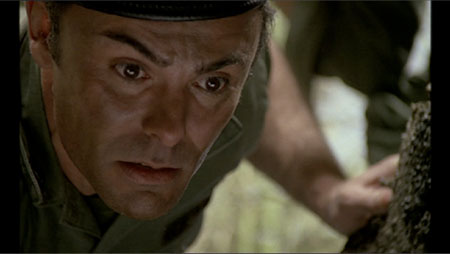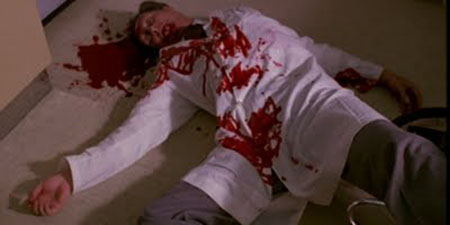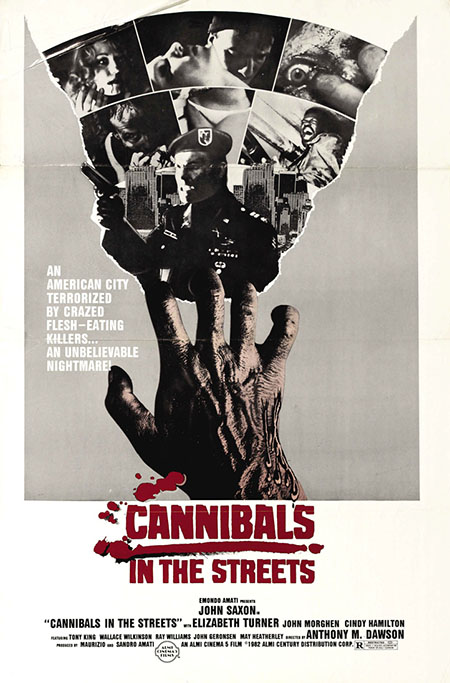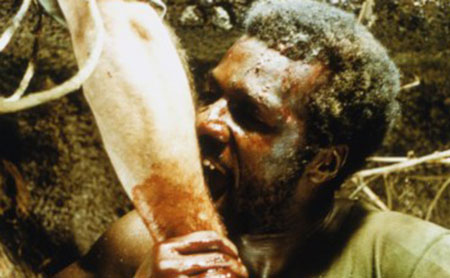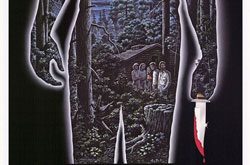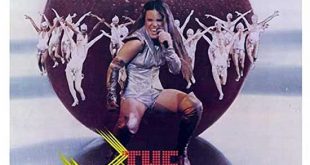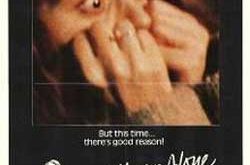SYNOPSIS:
Giovanni Lambardo Radice and John Saxon are Vietman vets that bring back contagious virus that turn people into cannibals when bitten.
REVIEW:
In so many of the cannibalsploitation films, we follow a group of “civilized” folks as they make their way into the green inferno in search of something or other. In almost every instance, from Cannibal Holocaust and Cannibal Ferox to The Green Inferno, the cannibals are the primitive indigenous people, living their lives without modern Western technology or morals, and the “good guys” are the white people/victims who make their way (uninvited) into uncharted territory with manifest destiny on their minds.
Most of these films have essentially the same plot, so it’s no wonder that, much like Nazisploitation, the subgenre all but faded away not long after it started. However, in 1980, director Antonio Margheriti and writer Dardano Sacchetti (see also Demons and many of Fulci’s best, i.e. The Beyond, City of the Living Dead, The New York Ripper, and more) brought us a new cannibal story, one set not in the deepest jungles of the Amazon, but rather in downtown Atlanta, Georgia.
The story starts in Vietnam, and is shown to us via flashback/nightmare: Norman Hooper (the legendary John Saxon) and a group of American soldiers drop into a village in Vietnam, taking out the enemy soldiers. They find a couple American POWs imprisoned there, Tommy Thompson (Tony King, from Shaft and The Toy) and Charlie Bukowski (I’ve said it before, but what a strange choice of character names – he is played by Giovanni Lombardo Radice, aka John Morghen, from House on the Edge of the Park and Cannibal Ferox). These American prisoners of war have apparently contracted some sort of sickness, one that has pushed them to cannibalism. While rescuing them, Hooper gets bit by Tommy, which becomes important when we reach present day and find Tommy and Charlie in a hospital for treatment, a regimen that Hooper has already successfully completed. As it turns out, whatever sickness these soldiers have contracted is similar to rabies in that it can be transmitted via bite.
Move forward to present day. Charlie is let out on leave from the hospital and contacts Hooper, who is afraid to meet up for fear of relapse. So Charlie heads out to catch a movie, where he bites a girl and then flees to a nearby flea market that happens to have a gun section. He takes a few people out before Hooper, having heard about the standoff, heads to the scene and talks some sense into him. Charlie heads back to the hospital and Hooper heads home, where his wife, Jane (Elizabeth Turner), is worried about him, his doctor, Phil Mendez (Ramiro Oliveros), thinks he should check into treatment (which would give the doctor time to make a move on Jane), and his very young looking neighbor, Mary (Cinzia De Carolis, who was 20 at the time of filming, but looks closer to 15), wants to find some alone time with her older neighbor. Of course, all of this takes a back seat when Charlie, Tommy, and a newly infected nurse, Helen (May Heatherly), break out of the hospital, with the help of Hooper, and leave a trail of blood and bodies behind them.
It’s not surprising that Cannibal Apocalypse (also known as Apocalypse Domani) was on the Video Nasties list. There is some intense blood and gore in this film, which makes sense when you take into account that it’s about people eating people. The chunk Charlie takes out of the girl in the theater is substantial, as are the holes left in the various bodies of Charlie’s gunshot victims. There are tongues bitten off, eyes poked out, heads bashed into car doors, and an especially nasty scene when Charlie and Helen cut the leg off a victim to keep as a snack for later, one that will make you want to avoid hamburgers for a couple of days. Add in the bizarre, spring-late autumn relationship blossoming between Hooper and Mary, and there is plenty for Mary Whitehouse and company to get all worked up over.
Cannibal Apocalypse is a different, and appreciated, take on the cannibal film subgenre, one rarely repeated when it’s so easy to just drop naïve Americans into the middle of a rainforest and watch them squirm without technology and fast food (while not perfect, Alexandre Michaud’s Urban Flesh also attempted the city-based cannibal story years later). And, as an added bonus, there are no real animal deaths in this film! At times it feels like a whole lot of story crammed in to a normal length film, but it does move along fairly smoothly, keeping the action going on a regular basis, filling in the short gaps between with backstory and necessary exposition, and ending with an ominous, if not somewhat expected, twist. It’s gory, it’s well acted, and it remains a fairly unique tale. If you already love the films of Deodato and Lenzi, you owe it to yourself to check out Cannibal Apocalypse.
 Horror News | HNN Official Site | Horror Movies,Trailers, Reviews
Horror News | HNN Official Site | Horror Movies,Trailers, Reviews

